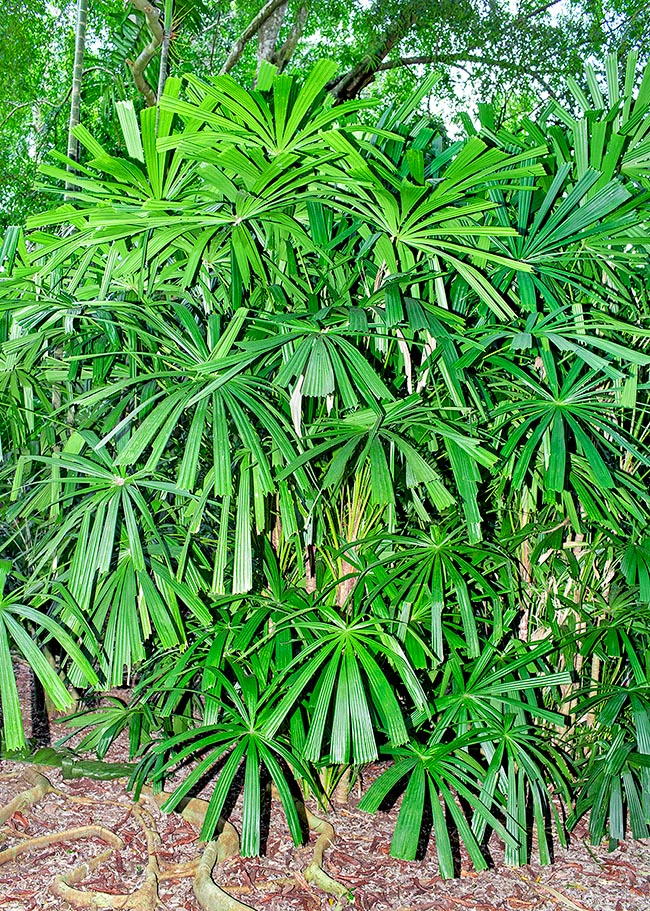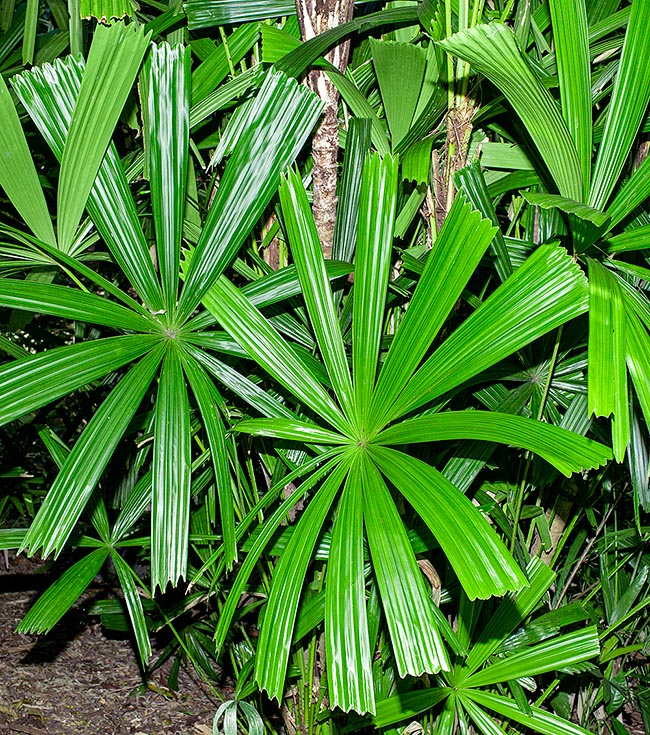Family : Arecaceae

Text © Alessandro Marini

English translation by Mario Beltramini

Native to SouthEast Asia, Licuala paludosa is present from the sea level to 900 m of altitude in swampy or bog forests and lands flooded for six or more months during the year. It does not stand temperatures under 16 °C © Giuseppe Mazza
Licuala paludosa Griff. is native to a vast area of the Indo-Chinese Peninsula that includes Cambodia, Thailand, Vietnam and Malaysia and is also diffused in Borneo. It lives in the swampy forests and in the peat bog forests, on lands flooded during six or more months during the year. In Borneo it is diffused in the plain and in the mountain forests, from the sea level up to about 900 m of altitude.
The name of the genus Licuala Wurmb is the Latinization of the name “lkowalà”, used by natives of the Maluku Islands to identify the species type Licuala spinosa Wurmb (1780).
The name of the species paludosa comes from the Latin “paludis” = of the swamp, with reference to the habitat where it grows.
Commonly it is known with the names: mangrove fan palm, swamp fan palm, golden licuala (English); ga-por (thai); cdy mat cat, na lat nan (Vietnamese); palas (Malay); Strahlenpalme (German).
Licuala paludosa is a monoecious, multi-stemmed species, forming dense shrubs up to 6 m tall and up to 9 m broad. The plants have thin stems, with a diameter of 5 cm, covered by brown fibres. The stems of the same shrub normally have all the same height.
Every stem is surmounted by a crown of 9-10 palmate leaves, circular and flat, up to 1,5 m broad, with the lamina completely divided up to the base in 7-20 bright green segments, all of the same size, run by evident veins, with truncated and toothed apex.
The petioles are very long, up to 2,5 m, and present on the margins small black thorns, 0,5 cm long, distributed from the base of the petioles to half of its length. In the plants exposed to the direct sun, the petioles may get a vivid orange colour, turning yellow or yellow/green in the specimens in the shade. The interfoliar inflorescences, erect and projected beyond the leaves, are ramified in 5-8 straight filiform rachillae, covered by down, 12-20 cm long. The small hermaphrodite flowers are glabrous and sessile and present short oval petals of cream colour.
The fruits are globose or ovoid, with an up to 1 cm diametre, of red-orange colour or completely red when ripe, and contain only one seed.
It reproduces by division of the tufts or by seed, which germinates in about 2 months, on a warm bed.

The leaves are intertwined to make hats, small baskets and food containers for a typical dish © Giuseppe Mazza
Licuala paludosa is quite similar to the congener Licuala spinosa, but looks more elegant, with bigger and thinner leaves and coloured petioles. The two species differ because Licuala paludosa has glabrous flowers and small and thin thorns, up to 0,5 cm long, distributed only in the basal half of the petiole, whilst Licuala spinosa has flowers covered by down and by big and robust thorns, up to 1,2 cm long, distributed along the entire petiole.
Licuala paludosa is very much sought for by the collectors, due to the characteristic colouration of the bright orange or gold yellow petioles, but is not a species too diffused outside the Indochinese countries, but the botanical gardens of the tropical countries. It can be cultivated only in the tropical or warm subtropical climates, with winter temperatures around 16 °C. In the temperate climates it must be sheltered in a warm greenhouse during the cold months.
It needs abundant availability of water and ambient humidity, of more than 70%. The soil must be peaty and rich in humus, maintained very humid. When grown in pot it must be kept with the saucer always full of water, in a warm environment.
The leaves of Licuala paludosa are utilized in the south-eastern Asian cuisine for a traditional dish called Ketupat, a sort of rice-based dumpling done in a small bag rightly made with the intertwined leaves of the species. They are also utilized to realize hats and small baskets. The stems are employed in the constructions of local dwellings.
Licuala paludosa is classified as “Not Evaluated” by the International Union for the Conservation of Nature (IUCN). Unfortunately, the conversion of vast Boneo areas of bog forests is a serious threat for this species. Based on current information, its range in Borneo is reduced to about 50 square kilometres. It keeps relatively diffused in the territory of the Indochinese peninsula.
Synonyms: Licuala amplifrons Miq., Fl. Ned. Ind.; Licuala oxleyi H.Wendl.; Licuala paniculata Ridl.; Licuala aurantiaca Hodel; Licuala spinosa var. brevidens Becc.
